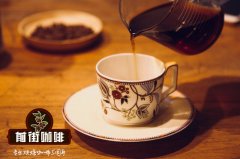Coffee study | is there any difference in the flavor of coffee beans in different plots of the same coffee farm?

Professional coffee knowledge exchange more coffee bean information please follow the coffee workshop (Wechat official account cafe_style)
[preface]
The concept of individual coffee is nothing more than coffee beans produced in a single producing area or manor, but if some estates have a relatively wide planting area, or if they are complex in altitude and micro-climate, then, if they are produced in the same manor, but how much difference will there be in the flavor of coffee beans between different plots?
Take Honduras [Sweet Orange Manor] as an example
Sweet Orange Manor (El Naranjo) is located in Marcala, one of the most famous producing areas in Honduras. Makala belongs to La Paz, which produces coffee on a par with Santa Barbara, another famous producing area in Honduras. The Caballero family also has a farm in Makala, and they won the 2016 championship on their farm in La Paz.
Last year, in 2016, Sweet Orange won the 14th place in the Outstanding Cup contest, and Carmen Fabiola Fiallos Melendez, the female banker, finally realized her dream of becoming a boutique coffee farmer. Carmen's husband was originally a coffee farmer. It was only after the couple got married that Carmen began to make coffee. The two work well together, she is in charge of the harvest and drying process, her husband is in charge of peeling and peeling, and they hope to pass on not only a coffee farm, but also a passion for coffee to their two children.
There are a number of high-quality coffee trees growing in the sweet orange manor in Honduras, 1425 meters above sea level. The manor is also named after the shade tree, so the shade tree of the sweet orange manor is a tall wild orange tree, the aroma of wild orange is very strong, there is a rare rich sweetness in growing coffee here, and orange fruit trees also inject rich flower and fruit aromas into the coffee. The varieties now grown on the estate are Kaddura, Bourbon and Rosa. In addition to fruit trees and coffee trees, the manor also has windbreak walls to protect coffee and fertilizer mainly composed of fresh coffee fruit shells.
[variety]
Kaduai is a kind of bean that we often encounter. In 1949, the Agricultural Research Institute (Instituto Agronomico;IAC) of Campinas in Sao Paulo, Brazil, crossbred the "New World" bean seed (Mundo Novo) with yellow Kadura (Yellow Caturra) to develop Kaduai, which was officially released in 1972 after several generations of selection.
Kaduai is very popular with farmers, high yield, similar to Kaddura, short plants, suitable for intensive cultivation, after its official release in the 1970s, it was extended to Central American countries, widely cultivated in Guatemala, Honduras, Panama, and origin Brazil. Simply considering the flavor, under the appropriate local conditions and treatment, Kaduai can have quite a wonderful flavor.
[washing treatment]
First remove the skin and pulp, then eliminate the stickiness of the gum with the help of fermentation, then rinse the pectin with water, and then dry it. The drying process usually uses sunlight, and sometimes a dryer is used. Unripe beans and defective beans are selected because of buoyancy, and the fermentation process is easier to control, so the flavor is not as sour as sun-cured beans, but obviously sour, more complex and cleaner.
No. 3: ordinary washing
No. 11: extended washing time
[raw beans and cup test]
The raw beans in plots 3 and 11 both look dark green with silver skin attached, but the baking is slightly different.
[land No. 3]
After 30 seconds, the firepower is adjusted to 160C, the yellowing point is 5:05 seconds, and the temperature is 152C. When the throttle is adjusted to 4180 degrees, the firepower is adjusted to 100C, the throttle is adjusted to 100C, the throttle is unchanged, and the firepower starts to explode in 8:30 seconds, and the temperature is 187.1 degrees.
Cup test flavor: high temperature entrance sweet, light sugar sweet, soft plum sour taste, sweet and sour shock, the end of oolong tea, low temperature sipping, sour taste is much brighter, citric acid is obvious, but the latter is not very long-lasting.
[land No. 11]
The entry temperature is also 195C, 30 seconds later, the firepower is adjusted to 160C, the yellowing point is 5:12 seconds, the temperature is 155C, the throttle is adjusted to 4168 °C, the firepower is adjusted to 140180 °C, the firepower is adjusted to 110C, the throttle remains unchanged twice, the explosion starts in 8:13 seconds, the temperature is 187.1 °C, and the development is 2:00 minutes after the first explosion, and the temperature out of the furnace is 197C.
Cup test flavor: the entrance has bright acidity at high temperature, citrus acid, green tea, sweet at low temperature, with malt flavor.
Comparing the two curves, the yellowing point of sweet orange beans is concentrated in about 5 minutes, and the main difference lies in fine-tuning.
On the 3rd, the temperature rises a little bit at the turning yellow point, and the firepower adjustment of the whole process is relatively less, and the throttle is fully opened when it explodes, while the firepower adjustment of the 11th place is a little more, and the temperature rise after turning yellow is relatively moderate, and the air door is not fully opened when it explodes. The development time of the first explosion and the furnace temperature are longer and higher, so the performance in the sense of sweetness is more lasting and full.
[hand impact comparison]
Parameters: cake cup, 90 degrees, grinding degree 5R, 5R, 1: 15, powder / water ratio, time: about 2:04 seconds.
Technique: 22-130-228g precinct 22g steam for 30 seconds, small water injection to 130g, second stage of water injection at 1:17, slightly larger flow to 228g, 1D stop injection for 50 seconds, wait for the water level to drop naturally, remove the filter cup at 2:04 second.
No. 3: bright yellow lemon and citrus sour taste, accompanied by the sweetness of sugar and the aftertaste of oolong tea. when it is cool, the sour taste is more sharp.
No. 11: the acidity is not as bright as that of No. 3, but it retains the acidity of citrus lively fruit, the sweetness is relatively obvious, body is smooth, with orange tail, and green tea.
Literally, the No. 11 sweet orange treated with lengthened water should be more sour than No. 3, but after baking and different firepower and throttle adjustment, the sour taste of No. 3 is brighter, so, to judge whether a bean is particularly sour, in addition to the punching method, you have to taste it carefully from baking and cup measurement.
Related recommendation: is hand-made coffee really good? Why does coffee smell better than it tastes?
Important Notice :
前街咖啡 FrontStreet Coffee has moved to new addredd:
FrontStreet Coffee Address: 315,Donghua East Road,GuangZhou
Tel:020 38364473
- Prev

How long does the coffee grow beans? how long can the coffee beans be kept?
Professional coffee knowledge exchange more coffee bean information please follow the coffee workshop (Wechat official account cafe_style) I do not know if you have had the same experience as the editor: just bought coffee beans, can not wait to drink, found that how to adjust the brewing data is not ideal, the result rushed to the 4th and 5th day, suddenly changed to taste good, thought that finally found a suitable brewing method, but
- Next

The introduction to single-door coffee starts with Yega Xuefei, the recommendation of individual coffee beans.
Professional coffee knowledge exchange more coffee bean information Please follow the coffee workshop (Wechat official account cafe_style) to feel the charm of good coffee. People who drink coffee frequently since "Yega Xuefei" must have more or less heard others say [Yega Xuefei], and even a lot of people have already started to know the acid from [Yega Xuefei], which is the first cup.
Related
- Beginners will see the "Coffee pull flower" guide!
- What is the difference between ice blog purified milk and ordinary milk coffee?
- Why is the Philippines the largest producer of crops in Liberia?
- For coffee extraction, should the fine powder be retained?
- How does extracted espresso fill pressed powder? How much strength does it take to press the powder?
- How to make jasmine cold extract coffee? Is the jasmine + latte good?
- Will this little toy really make the coffee taste better? How does Lily Drip affect coffee extraction?
- Will the action of slapping the filter cup also affect coffee extraction?
- What's the difference between powder-to-water ratio and powder-to-liquid ratio?
- What is the Ethiopian local species? What does it have to do with Heirloom native species?

